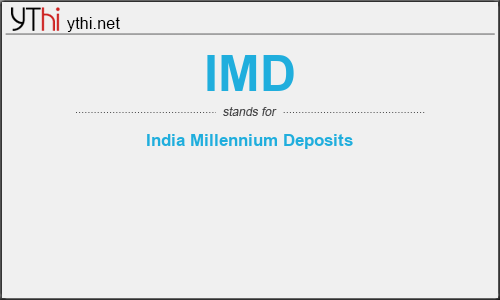What does IMD mean? What is the full form of IMD?
The full form of IMD is India Millennium Deposits.
The India Millennium Deposit Bonds (IMDs), issued by the State Bank of India in 2000 came up for redemption on December 29, 2005. The Reserve Bank of India (RBI) estimated a total outflow of $7.3 bn foreign exchange on the redemption of these bonds. RBI, in coordination with the State Bank of India has made necessary arrangements for the redemption of the India Millennium Deposits (IMDs) smoothly, in time and without causing any adverse impact on the money markets. The redemption arrangement was met by RBI by way of direct sale of its foreign exchange reserves to SBI at the prevailing market rate of Rs. 45.34 against the dollar. The rupee consideration for the sale, which was at around Rs. 330 bn, will be paid by SBI and the bank has taken steps to mobilize rupee resource to purchase foreign exchange from RBI. As per the agreement, at the time of the issue of IMD the exchange loss on account of depreciation of rupee is shared between the bank and the Government of India. The RBI in its press notification said that there could be no hiccups in outflow of foreign exchange considering the present liquidity conditions in the market. “We are in constant discussion with SBI to take care that IMD redemption is as eventless as the Resurgent India Bond redemption was.” Dr. Rakesh Mohan, Deputy Governor, RBI said in a press conference. He added: “There is no general problem of liquidity given the amount we still have in the Market Stabilization Scheme.”
On December 28, 2005, Reserve Bank of India (RBI) sold $5.107 bn to the State Bank of India, the country’s largest bank, for the redemption of IMDs. Out of the total amount, $4.569 bn was in US dollars, another 233.259 million in pound and 113.176 million in euros. The balance $1.97 bn that was to be sold to SBI entirely by RBI was to be met by way of direct sale out of its foreign exchange reserves to SBI on December 29, 2005
IMD
means
India Millennium Deposits![]()
Translate India Millennium Deposits to other language.


Leave a Reply
You must be logged in to post a comment.